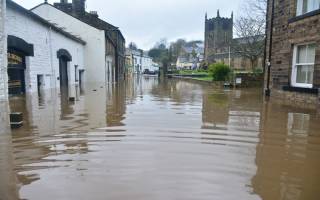Past Projects
- UKRI GCRF Multi-Hazard Urban Disaster Risk Transitions Hub
- Aiming to enhance sustainable urban development, catalysing a transition from crisis management to disaster risk-informed planning and decision-making in cities in developing countries.

- EPSRC Plastic Waste Innovation Hub
- The hub acts as the interface between a diverse team of UCL researchers and industry, government, and the public to help solve the plastic waste catastrophe.

- “Circular” financing and governance models for adaptive reuse of cultural heritage (CLIC)
- Find out more about our work identifying evaluation tools to test and implement “circular” financing and governance models for adaptive reuse of cultural heritage.

- Prioritising Sustainable Energy Choice in Cities (2014-2018)
The study developed a practical approach to produce integrated action plans, enabling cities to manage and invest their infrastructure more effectively to achieve long-term impacts in energy and climate action. The work will involve a critical review of the existing tools to assist cities, and define and consolidate a new methodology to achieve overall long-term energy sustainable plans. The proposed methodology will address how such investment strategies can be structured, including how associated risks can be characterised, in order to attract funding from long-term investors.
Despite the fact that new renewable energy (RE) or energy efficiency (EE) projects could simultaneously reduce energy consumption whilst also maximising supply from renewable energy sources, securing investment for smart energy projects has been difficult. This is because they are perceived as too risky due to their long life cycles, reliance on novel technology, and economic constraints.
The key idea behind this work is to explore ways to foster increased investment in RE/EE (smart energy) projects for cities in order to encourage greater sustainability and resilience. In so doing, we investigate ways to better quantify the value of an urban energy infrastructure project and to express project risks so that they are more manageable for institutional investors.
In order to accomplish the aim of improved valuations for energy infrastructure projects, we analyse two Real Options Valuation (ROV) techniques that make use of fuzzy numbers. Real options help to derive valuations for projects where investment decisions must be made under uncertainty, and fuzzy numbers are a way of capturing project uncertainty so that it can be more easily analysed. Both Fuzzy ROV methods will be used to perform a projected cashflow analysis on an urban energy project because while the two approaches use similar inputs, they use different techniques to calculate the value of the real option. We argue that since Fuzzy ROV methods are capable of capturing and factoring in different types of risks when making valuations, they may simplify the calculation of the real option value and profitability analysis as a whole.
The application of two Fuzzy ROV techniques to smart energy projects resulted in a comparative analysis between the models as compared to the traditional net present value estimate, shown below.
To follow on from this work in improving the investment prospects of smart energy projects, we are also undertaking work in investigating the use of innovative financial instruments in order to unlock capital for use by municipalities in order to finance smart energy schemes, because affordable capital is needed to work in synergy with viable smart energy business models in order to create momentum in the clean energy sector. Specifically, we have performed an analysis of the green municipal bond market in the United States, because there is a growing green bond market sector that is being used by cities in order to finance renewables and energy efficiency projects in American cities. The key question is whether the green bond mechanism is viable and reliable, and whether or not a green municipal bond-type instrument can be deployed in the European context.
By investigating the secondary market performance of these bonds, we can assess the level of demand for green municipal bonds. We also explore the types of projects that are being financed by these bonds, and going forward we will also investigate the accountability of the use of proceeds, particularly whether or not the money raised by the green municipal bonds is indeed used to fund clean energy infrastructure as promised.
- Analysing complex energy infrastructure investment decisions using real options analysis and agent based models (2013-2017)
Over the next few decades it is anticipated that European countries will move their energy generating portfolios towards an intermittent renewable source in an attempt to meet ambitious targets (i.e. 2020 Kyoto protocol). This shift will result in an energy base load that can easily be switched on and off to an energy base load that is highly intermittent in nature due to the intermittent nature of many renewable energy source (i.e. wind and solar). To account for this a vast amount of energy infrastructure investment, from both government and private sources, will be required over the next few decades in order to create an “EU super grid”.
Iain’s research focuses on these energy infrastructure investment decisions by analysing future cash flow of potential infrastructure investments in order to gauge attractiveness of the investment to private companies and determine appropriate government subsidies for the investment. The research has two main strands:- Development of agent based models in between European countries. The agents in this model include generators, end users, governments, and privately operated high voltage interconnectors which connect European power grids. The generation portfolio between the countries is then altered to simulate future energy generation. This has an effect on both the wholesale energy price as well as the volume transfer between the two European states via the independently owned high voltage interconnector.
- Real options analysis to analyse the future cash flow potential of energy infrastructure investments based on multiple scenarios developed in from the agent based models.
Outputs:- Simulation of Spanish, Portuguese and Italian electricity prices using Monte Carlo modelling techniques.
- Theoretical high voltage interconnector investment returns for different Italian and Spanish generating portfolios calculated using real options analysis.
Working Papers:
[1] A Real Options Approach for Analysing Complex Energy Infrastructure Investments: Connecting the Spanish Power Grid Case Study.
[2] Agent based modelling techniques to analyse the effect of changing energy generating portfolios in Western Europe on European wholesale energy prices.
- Liveable Cities: Transforming the Engineering of Cities to Deliver Societal Wellbeing (2012-2017)
The vision of this project is to transform the engineering of cities to deliver a global, societal and individual wellbeing within the context of low carbon living and resource security. To achieve this vision the project’s ambition is to create a holistic, integrated and truly multidisciplinary city analysis methodology funded in wellbeing indicators based on social, environmental, economic, and governance factors. Our research work within this project focuses on the study of economic factors that encourage a stable and green economy. Our aim is to define new ways to support and foster sustainable investments in cities and regions. This general objective is achieved through the implementation of two main concepts: the portfolio approach to urban investments and the evaluation of natural capital and its integration into the economy of a region.
Alessandra’s initial research focuses on implementing the portfolio approach, developed in previous studies, in the city’s Enterprise Zones. Enterprise Zones are specific urban areas launched recently by the UK National Government to drive sustainable economic growth. By evaluating the financial return and the socio-environmental impact of Enterprise Zone projects, the portfolio approach is capable of providing decision makers and local authorities with a clearer choice of which investments composition is best-suited to their own context. Simultaneously, it allows attracting private investors, strengthen the resilience of the city and yield benefits for its citizens.
Minette’s work focuses on formalizing the mathematical model of the portfolio and optimizes its performance. To achieve this, she develops a new framework to measure socio-environmental impacts of investments and their interactions.
Raul’s research focuses on studying the value of Natural Capital as a fundamental part of the Inclusive wealth concept, along with its integration with human, social and fixed capital in regions. His current work aims to analyse alternatives for authorities to invest in the natural assets of a region, in order to maintain and recover the value of natural capital, and therefore increase wealth and achieve sustainable development goals.
Working papers:
[1] A. Coda and F. Medda (2014). Portfolio Approach to support investment in Enterprise Zones: The case of Birmingham. Working paper 1423. 54th European Regional Science Association Congress.
[2] R. Martinez Oviedo and F. Medda, (2014). Building the Green Economy with Sovereign Wealth Funds. Working paper 1404. 54th European Regional Science Association Congress
- A Financial Investment Toolkit for Critical Infrastructure (2012-2017)
The main aim of this study is to develop an engineering toolkit to identify a portfolio of alternative financial tools specific to critical infrastructure projects all the way through the project life-cycle -- from feasibility assessment, design and construction-- to operation and maintenance. It is hoped that the toolkit will stimulate increased private sector participation by providing a means of mitigating the risks that seem to be a major stumbling block to private investment. The aim of the toolkit is to enlarge the pool of financial resources and funding mechanisms for infrastructure investment. The outputs of this work are:
1) To develop a toolkit for project sponsors to define a portfolio of alternative financial resources;
2) To understand the risks specific to the infrastructure that hinder private investment.
Publications- Panayiotou, A.; Medda,F. forthcoming, "Portfolio of Infrastructure Investments: An analysis of the European cases", Journal of Infrastructure Systems.
- Panayiotou, A.; Medda, F (2014), "Attracting Private Sector Participation in Transport Investment”, Procedia - Social and Behaviour Science, 111(5), pp. 424-431.
- Panayiotou, A.; Medda, F (2014), "Attracting Private Sector Participation in Infrastructure Investment: the UK case", Public Money and Management Journal, 34(6), pp. 425-431.
Conference Proceedings- Panayiotou, A & Medda, F (2015). “Constructing a Portfolio of Infrastructure Investments a Comparative Analysis of Portfolio Re-balancing Strategies”, Regional Science Association, Winter Conference, London, United Kingdom
- Panayiotou, A & Medda, F (2015). Portfolio Infrastructure Investments: an Analysis of the European and UK Cases. International Symposium for Next Generation Infrastructure Conference Proceedings: 30 September - 1 October 2014 International Institute of Applied Systems Analysis (IIASA),Schloss Laxenburg, Vienna, Austria, 81-83. London, UK: UCL STEaPP
- Medda, F., Caravelli, F., Panayotou, A., & Rapti, E. (2015). Portfolio Structuring Model for Urban Infrastructure Investments. International Symposium for Next Generation Infrastructure Conference Proceedings: 30 September - 1 October 2014 International Institute of Applied Systems Analysis (IIASA),Schloss Laxenburg, Vienna, Austria, 63-65. London, UK: UCL STEaPP.
- Panayiotou, A; Medda, F (2014). "Portfolio of Infrastructure Investments: An analysis of the European and UK cases" Conference Proceedings, 21st Annual Conference of the Multinational Finance Society, Prague, Czech Republic.
- Panayiotou, A., & Medda, F. R. (2014). Attracting Private Sector Participation in Transport Investment. TRANSPORTATION: CAN WE DO MORE WITH LESS RESOURCES? - 16TH MEETING OF THE EURO WORKING GROUP ON TRANSPORTATION - PORTO 2013, 111, 424-431. doi:10.1016/j.sbspro.2014.01.075
- INFRARISK (2013-2016)
In Europe, extreme natural hazard events can have a devastating impact due to the complex interdependency of critical infrastructure systems. Using novel indicators for identifying critical INFRAstructure at RISK from natural hazards, the aim of the INFRARISK project is to develop a stress test framework to tackle the coupled impacts of natural hazards on interdependent infrastructure networks through. We are involved in the INFRARISK WP6 work package, which incorporates stress tests for multi-risk scenarios. The objective of our research is to estimate the indirect economic impacts of natural hazards, specifically how infrastructure disruption due to natural hazards impacts on the regional economy, and for appraising the possible investment to increase the resilience of the system. The general research framework for this purpose is as follows:
- The Transport infrastructure hazard response simulator is an Agent-Based Model which simulates transport infrastructures responses to an extreme natural hazard so that the road damages due to the natural hazard can be visualized.
- The Traffic simulator simulates the traffic flow under the natural hazard scenario based on the output of Transport infrastructure hazard response simulator. The simulator simulates the car speed limits, traffic link densities as well as time delay between cities.
- The Indirect economic impact assessment module evaluates indirect economic impact of natural hazards.
A correlation between traffic demand and regional economy has been set up. It is expected that the overall cascading effect of natural hazards on the infrastructure system can be quantitatively evaluated for the purpose of infrastructure project investment. The research result is expected to be applied to local government or infrastructure investors when evaluating investment risks of infrastructure projects.
Working papers:
[1] Miao Wang, Francesca Medda, Dina D’Ayala and Pierre Gehl (2015) Indirect economic impacts of natural hazards: an application of agent-based modelling. Regional Studies Association Winter Conference 2015, London
Publications
For updated lists of our academics' publications, please visit their UCL IRIS pages:
Professor Francesca Medda
Dr Maurizio Fiaschetti
Dr Ramin Okhrati
Dr Chao Liu
Professor Sir Alan Wilson (Director of Research)
 Close
Close



